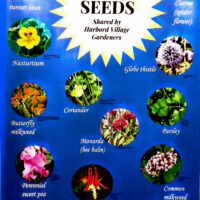 This page has basic ID and growing instructions for seeds given away by the Harbord Village Gardeners at the 2024 HVRA Fall Fair. They include varieties shown in the poster created by Amy Furness for display at the Gardeners’ table, and more besides.
This page has basic ID and growing instructions for seeds given away by the Harbord Village Gardeners at the 2024 HVRA Fall Fair. They include varieties shown in the poster created by Amy Furness for display at the Gardeners’ table, and more besides.
-
- Native perennials are listed below in green font — they grow reliably in our area, and they attract and nourish pollinators. It can be hard to find seeds for these varieties, so locally collected ones are valuable finds.
- Most of our packages contain seeds harvested in Fall 2023. They were stored carefully and the seeds are still good to use. You could plant extra to be sure of ample sprouting.
Calendula: Ancient annual flowering herb 30cm tall, yellow & orange daisy-like flowers attract pollinators. Sprinkle or direct sow in early spring; thin to10cm apart.
Canadian columbine. Native perennial, self-seeds to form clumps 30-40cm tall. Red and yellow flowers, spring to early summer, blooms in part shade. Plant in spring, keep seedlings watered.
Coriander. Flavourful annual herb with white flowers that bees like. Leaves disappear in hot weather, but can be re-sown in cooler weather. Sprinkle on ground in fall or spring.
Cleome. 1m tall annual, attracts pollinators. Sprinkle seeds in late fall or plant in June. Germinates only when days/nights are warm, then grows fast.
Dill. Ferny green leaves are good as herbs, tiny white flowers attract bees and other pollinators. They self-seed easily but can easily be pulled out and eaten at any stage. Scatter seeds in June and cover very lightly so seeds are exposed to the sun.
Foxglove Beardtongue (Penstemon digitalis). Tall native perennial, strong upright stems with bright white tubular flowers in May and June that attract bees and hummingbirds. Likes full sun. Scatter tiny seeds in the Fall, cover lightly.
Globe thistle. 1.5 to 2m high perennial, dramatic blue flowers beloved by bees. Expose seeds to cold temp for several weeks before planting outside or inside; thin to 70cm apart.
Hollyhock. Very tall perennial or biennial, self-seeding; attracts bees. An old-fashioned favourite with large flowers, range of colours. Scatter on ground in fall or start inside, thin or transplant to 60cm apart.
Blue Wild Indigo. A tall shrub-like native perennial that keeps its shape and produced handsome seedpods after longlasting summer bloom. Bright blue flowers, attractive to pollinators. Now quite rare. Needs cold spell to germinate; scatter seeds in fall or keep in fridge during winter and plant shallowly in spring. Will bloom in 2nd or 3rd year.
Sundial Lupine. Native perennial, blue, pink or white flowers. Grows fast from seed, but thrives only in dry sandy sunny conditions. Host plant to Karner butterfly. Scratch seeds before planting. Plant is toxic if ingested.
Milkweed — pink (swamp). Tall native perennial, essential host for Monarch butterflies. Open pods and scatter seeds in November, or plant in early spring. Blooms second year.
Milkweed — orange (butterfly plant). Medium-height native perennial, host to Monarch butterflies. Open pods and scatter seeds in November, or plant in spring. Blooms in second year. A new favourite in pollinator gardens. (These seeds are quite rare.)
Monarda (Spotted Bee Balm). Native perennial, scented pink blooms. Grows to 1m high, 70cm wide. Part shade to full sun, prefer moist soil. Plant tiny seeds inside or outside in protected pots, transplant 25cm apart in the spring.
Nasturtium. Annual, edible leaves and bright-coloured flowers. Plant in ground or container in late May; emerges in 10 days, blooms in 5-6 weeks. Don’t fertilize.
Obedient plant. Native perennial. Grows in shade or sun, white flowers, about 2 feet tall. Drought and salt tolerant; don’t overwater.
Perennial sweet pea. Some varieties are native perennials. Vine grows to 3m high and 2m wide. Pink or purple flowers. Sprinkle seeds in early fall or plant in container or ground in spring. Full sun or part shade.
Scarlet runner beans (“Jack and the Beanstalk.”) Fast-growing annual vine. Bright red flowers attract pollinators and hummingbirds. Plant 10cm apart in full sun early June. Provide support. Water well.